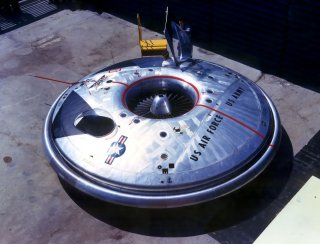Meet Avro Project 1794: The Air Force's Very Own Flying Saucer
It looked cooler than it really was.
In April the Department of Defense (DoD) formally released three U.S. Navy videos that contain “unidentified aerial phenomena,” but whether that actually means “UFO” is still a matter for debate. The videos will likely only fuel a debate on what is “out there,” but in recent years declassified documents have revealed the “truth” about some flying saucers and other seemingly otherworldly aircraft.
Rather than being flown by little green men from some distant planet, one flying saucer was very much of this Earth. It was part of the United States Air Force’s Project 1794, an effort to develop a supersonic craft that could be used to shoot down Soviet bombers.
In the early 1950s the Air Force began to work with the Canadian-based Avro Aircraft to develop an attack craft that was unlike the jet fighters of the era. Rather than featuring the standard wing and fuselage design it was literally a saucer-shaped vehicle. In theory its designers believed it would have a top speed between Mach 3 and Mach 4, a ceiling over 100,000 feet and a maximum range of 1,000 nautical miles.
According to unclassified documents, it would utilize vertical take-off and landing (VTOL) capabilities that would negate the need for conventional runways and could theoretically be deployed almost anywhere. The completely circular design would have also embodied inherent stealth characteristics.
In other words, it would be something “out of this world” almost literally.
In September 2012 the United States National Archives released the declassified records from the Aeronautical Systems Division, USAF (RG 342—Records of United States Air Force Commands, Activities, and Organizations). This included cutaways of the aircraft structure, which the National Archives noted, “bear a strong resemblance to ‘flying saucers’ in popular science fiction films made during the years these reports were created: 1956 and 1957.”
The question to ask is whether the Avo Project 1794 was perhaps one of those “UFOs” that people reported to have seen in the 1950s. However, that is unlikely.
The vehicle in question probably couldn’t do the things the designers said it could do.
One only needs to look as far as the VZ-9 Avrocar, a variant saucer funded by the U.S. Army, which sought a low-flying VTOL craft. It was originally specified for a maximum speed of 300mph and a serviceable ceiling of 10,000 feet. Despite the best efforts the craft was never able to fly more than a few feet off the ground and never faster than 35mph.
Wind tunnel tests proved that the aircraft had insufficient control for high speed flight and was aerodynamically unstable. If it flew more than three feet above the ground the Avrocar displayed uncontrolled pitch and roll motions.
Rather than a high flying saucer, the Army’s Avrocar was little more than a slow moving hovercraft. The project was canceled in 1961 and the Canadian firm closed its doors a year later. One of the Avrocar prototypes is now on display at the National Museum of the United States Air Force in Dayton, Ohio. A second prototype went to the U.S. Army Transportation Museum at Fort Eustis, Virginia.
The truth may or may not be out there, but the U.S. military’s attempt to develop a flying saucer took off like a lead balloon.
Peter Suciu is a Michigan-based writer who has contributed to more than four dozen magazines, newspapers and websites. He is the author of several books on military headgear including A Gallery of Military Headdress, which is available on Amazon.com.
Image: Wikimedia

